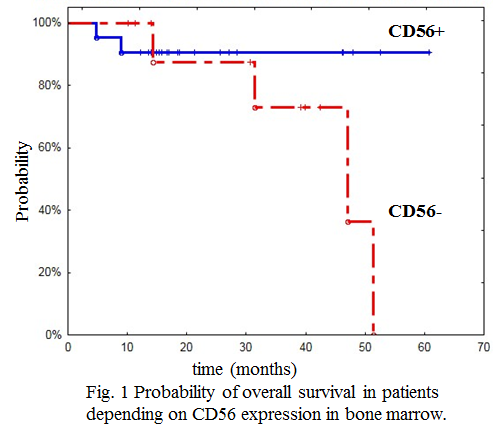
Contributions
Abstract: PB2000
Type: Publication Only
Background
The myeloma cells interact with the bone marrow microenvironment by several adhesion molecules. One of them is CD56 (a neural cell-adhesion molecule N-CAM) – a membrane glycoprotein, a member of the immunoglobulin superfamily, expressed on the surface of malignant plasma cells of patients with multiple myeloma (MM). Decreased expression of CD56 is considered as one of the possible factors, that help tumor cells to spread outside the bone marrow.
Aims
To evaluate the impact of CD56 expression on the rate of overall survival (OS) in MM patients with extramedullary disease (EMD).
Methods
The study included 32 patients with primary MM (17 males, 15 females) 23-77 years old (median value: 52 years old). The disease was diagnosed in accordance with the IMWG criteria (2014). 17 patients had EMD including 14 patients with soft-tissue plasmacytomas associated with bone and 3 patients with extramedullary foci in the neck area, in the stomach, in the liver. In all cases a tumour biopsy and bone marrow trephine biopsy were performed, that confirmed the presence of malignant plasma cell infiltration. Paraffin block slices from trephine biopsy material and tumour biopsy material were used to perform an immunohistochemistry (IHC) analysis with an antibody to CD56. Kaplan-Meier survival curves were generated, statistical analysis was done using the program «Statistica» ver.10.
Results
In patients with plasmacytomas the IHC analysis of trephine biopsy material showed CD56+ in 59% cases vs. 73,4 % in patients without EMD. Five-year OS in patients with CD56+ in the bone marrow was 90%, which was significantly higher (р=0,04) than that of the patients with CD56- - 0% with follow-up of 5 to 61 months (median 20 months, Fig.1). Expression of CD56 on the surface of extramedullary MM cells was found in 76,5 % patients. OS in the group of patients with CD56+ in extramedullary MM cells and in bone marrow cells (n=9) was 67% which was significantly higher (р=0,04) than that in the group of patients (n=4) with CD56+ in extramedullary MM cells and CD56- in bone marrow cells – 50%. Simultaneous lack of CD56 in extramedullary MM cells and in bone marrow cells was observed in 3 patients with 2 of them died of progression in 31 and 51 months. However simultaneous expression of CD56 in extramedullary MM cells and in bone marrow cells was observed in 9 patients with median follow-up of 40 months and 1 patient died of progression after 47 months.

Conclusion
CD56 expression in bone marrow plasma cells significantly increases the OS rate in MM patients regardless the presence or absence of plasmacytomas. Double CD56 negativity both in extramedullary and bone marrow MM cells is a poor prognostic factor with high risk of early relapse and death.
Session topic: 14. Myeloma and other monoclonal gammopathies - Clinical
Keyword(s): Multiple Myeloma, CD56, Plasma cells
Abstract: PB2000
Type: Publication Only
Background
The myeloma cells interact with the bone marrow microenvironment by several adhesion molecules. One of them is CD56 (a neural cell-adhesion molecule N-CAM) – a membrane glycoprotein, a member of the immunoglobulin superfamily, expressed on the surface of malignant plasma cells of patients with multiple myeloma (MM). Decreased expression of CD56 is considered as one of the possible factors, that help tumor cells to spread outside the bone marrow.
Aims
To evaluate the impact of CD56 expression on the rate of overall survival (OS) in MM patients with extramedullary disease (EMD).
Methods
The study included 32 patients with primary MM (17 males, 15 females) 23-77 years old (median value: 52 years old). The disease was diagnosed in accordance with the IMWG criteria (2014). 17 patients had EMD including 14 patients with soft-tissue plasmacytomas associated with bone and 3 patients with extramedullary foci in the neck area, in the stomach, in the liver. In all cases a tumour biopsy and bone marrow trephine biopsy were performed, that confirmed the presence of malignant plasma cell infiltration. Paraffin block slices from trephine biopsy material and tumour biopsy material were used to perform an immunohistochemistry (IHC) analysis with an antibody to CD56. Kaplan-Meier survival curves were generated, statistical analysis was done using the program «Statistica» ver.10.
Results
In patients with plasmacytomas the IHC analysis of trephine biopsy material showed CD56+ in 59% cases vs. 73,4 % in patients without EMD. Five-year OS in patients with CD56+ in the bone marrow was 90%, which was significantly higher (р=0,04) than that of the patients with CD56- - 0% with follow-up of 5 to 61 months (median 20 months, Fig.1). Expression of CD56 on the surface of extramedullary MM cells was found in 76,5 % patients. OS in the group of patients with CD56+ in extramedullary MM cells and in bone marrow cells (n=9) was 67% which was significantly higher (р=0,04) than that in the group of patients (n=4) with CD56+ in extramedullary MM cells and CD56- in bone marrow cells – 50%. Simultaneous lack of CD56 in extramedullary MM cells and in bone marrow cells was observed in 3 patients with 2 of them died of progression in 31 and 51 months. However simultaneous expression of CD56 in extramedullary MM cells and in bone marrow cells was observed in 9 patients with median follow-up of 40 months and 1 patient died of progression after 47 months.

Conclusion
CD56 expression in bone marrow plasma cells significantly increases the OS rate in MM patients regardless the presence or absence of plasmacytomas. Double CD56 negativity both in extramedullary and bone marrow MM cells is a poor prognostic factor with high risk of early relapse and death.
Session topic: 14. Myeloma and other monoclonal gammopathies - Clinical
Keyword(s): Multiple Myeloma, CD56, Plasma cells


